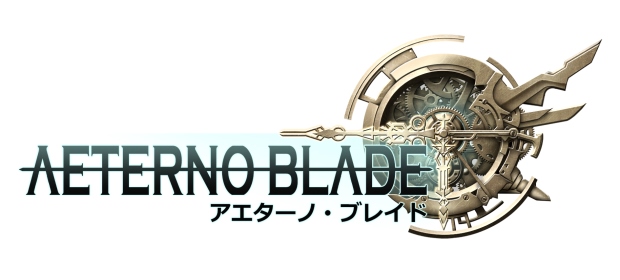Castlevania used to be a hugely important franchise for Nintendo’s handhelds. Post Symphony of the Night, the 2D ‘Metroid-vania’ designs made frequent appearances on the GBA and DS, with a new instalment lurching to life every few years. However, since the Lords of Shadow reboot, and Koji Igarashi’s extended vacation from the franchise, Castlevania has only paid one visit to a Nintendo handheld in the form of the mostly disappointing Castlevania: Lords of Shadow: Mirror of Fate.
Clearly someone at Corecell Technology saw this wrong and wanted to make it right, and Aeterno Blade is their, admittedly somewhat thrifty, attempt.
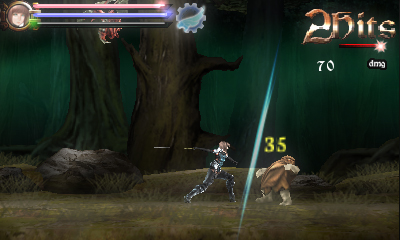 AeternoBlade’s narrative is pure shlock. You take the role of Freyja, a character who has sworn vengeance against Beladaim, a huge, cloak-wearing, fireball-throwing demon who has destroyed her home. You begin the game viewing Freyja’s death, and every level is pitched to you with a message telling you how many days are left before Freyja cops it. It’s not a whole lot of framing, but it works.
AeternoBlade’s narrative is pure shlock. You take the role of Freyja, a character who has sworn vengeance against Beladaim, a huge, cloak-wearing, fireball-throwing demon who has destroyed her home. You begin the game viewing Freyja’s death, and every level is pitched to you with a message telling you how many days are left before Freyja cops it. It’s not a whole lot of framing, but it works.
When you first take control of Freyja, impressions aren’t too good. A single, lacking jump is accompanied by very basic attack strings, and with no sort of defence or dodge available the whole thing lacks oomph or pizazz. The Castlevania comparisons rear their head instantly, mainly through the artstyle, but when you begin AeternoBlade the gameplay won’t give you much enthusiasm to carry on.
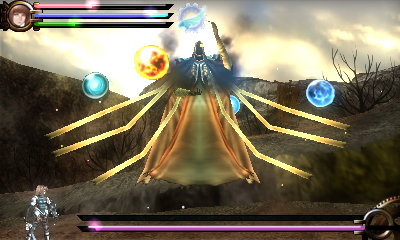 Within a short while, mind, you’ll begin to invest yellow orbs (obtained from killing enemies) into upgrades and new skills. Among these skills is a dodge for your L button (very ‘vania) and a host of extra attacks for your combo that will give the combat a lot more flow and verticality. In truth, the game shouldn’t make the dodge an unlock considering how much of an essential technique it is. It’s like offering you an Ice Cream and asking if you want a flake. Of course I want a blummin’ flake, otherwise it’s just bland old vanilla! But with flake (dodge) in ice cream (hand), it becomes a far more palatable offering.
Within a short while, mind, you’ll begin to invest yellow orbs (obtained from killing enemies) into upgrades and new skills. Among these skills is a dodge for your L button (very ‘vania) and a host of extra attacks for your combo that will give the combat a lot more flow and verticality. In truth, the game shouldn’t make the dodge an unlock considering how much of an essential technique it is. It’s like offering you an Ice Cream and asking if you want a flake. Of course I want a blummin’ flake, otherwise it’s just bland old vanilla! But with flake (dodge) in ice cream (hand), it becomes a far more palatable offering.
Customisation also includes relics. You can find lots of these from slaying enemies, and you can then equip a certain amount to apply buffs to your stats. Furthermore the levels contain power-up relics that can be assigned to further improve the main relics. All of these things are hidden around the levels, and you’ll need to backtrack and solve the more complicated puzzles to find them. These buffs are not only meaningful, but fun to track down.
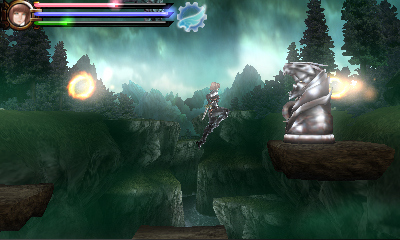 So there’s running, hacking, slashing, and a few RPG levelling-up mechanics. So far, so ‘vania. There’s also a lot of platforming, too, and it’s here that the game’s unique time manipulation elements come to the fore. The first key ability you find allows you to reverse the world around you while you retain full control, while the second is a teleport rune – leave it somewhere and you can zip back instantly with a button tap.
So there’s running, hacking, slashing, and a few RPG levelling-up mechanics. So far, so ‘vania. There’s also a lot of platforming, too, and it’s here that the game’s unique time manipulation elements come to the fore. The first key ability you find allows you to reverse the world around you while you retain full control, while the second is a teleport rune – leave it somewhere and you can zip back instantly with a button tap.
The teleportation admittedly gets a far richer workout than the rewind, but both have their place, particularly in exploration and boss fights. The rewind, for instance, can be used to exploit the vulnerable animation loops of larger foes, while some boss attacks require forward planned teleportation to avoid. These techniques are governed by a mana meter, however, which means you can’t abuse them.
 While we’re on the subject of bosses, though, let’s talk about the big boys. Often a highlight of this sort of action adventure, the bosses in AeternoBlade are a mixed bag. Design wise the majority of them are a muddy mess – true for much of AeternoBlade’s low-budget presentation – but some of their attack patterns are just simply obnoxious. It’s normally a case of indistinct tells, or poor animation clarity, but it’s a shame to admit that most of AeternoBlade’s bosses are hard to fight not because they demand skill, but because they’re frustratingly designed.
While we’re on the subject of bosses, though, let’s talk about the big boys. Often a highlight of this sort of action adventure, the bosses in AeternoBlade are a mixed bag. Design wise the majority of them are a muddy mess – true for much of AeternoBlade’s low-budget presentation – but some of their attack patterns are just simply obnoxious. It’s normally a case of indistinct tells, or poor animation clarity, but it’s a shame to admit that most of AeternoBlade’s bosses are hard to fight not because they demand skill, but because they’re frustratingly designed.
The janky presentation, too, is a frequent issue. Putting aside a few key areas, in particular the final level, the stages in AeternoBlade aren’t too remarkable. Screens and screens of unavoidable enemy encounters abound, making AeternoBlade’s puzzle-focused diversions and more platform-intensive sections a welcome change of pace. Oh and, another note for the Castlevania fans, a few of the platforming areas certainly give clocktower vibes…
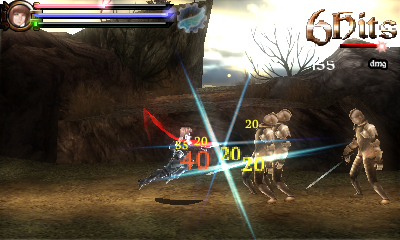 AeternoBlade is certainly a worthy diversion. It’s a chunky adventure, clocking in somewhere around 8-10 hours with a smidgen of backtracking, or closer to the 15-20 hour mark if you want to uncover everything. It’s a game that does quite a lot quite well, so it’s worth digging past the wiggly sword animations and lacklustre boss designs to find it.
AeternoBlade is certainly a worthy diversion. It’s a chunky adventure, clocking in somewhere around 8-10 hours with a smidgen of backtracking, or closer to the 15-20 hour mark if you want to uncover everything. It’s a game that does quite a lot quite well, so it’s worth digging past the wiggly sword animations and lacklustre boss designs to find it.
VERDICT: Aeterno Blade is Castlevania on a budget. Messy visuals, whiffy animation, endlessly recycled enemies, middling bosses. The combat starts a bit bad, too, but gets significantly better about thirty minutes in. All that said, Aeterno Blade is still worth mentioning in the same breath as Castlevania. Some cute time manipulation adds puzzle-y fun to the platforming, and while no element of the game is outstanding it’s all still worthwhile entertainment. Aeterno Blade is particularly recommendable to anyone hungry for the Castlevania/Metroid-like experiences that the 3DS has been so criminally denied. And as far as Metroid-vania goes, I actually enjoyed it a bit more than Mirror of Fate, so there’s also that…

GOOD. A game that scores 7/10 is worthy of note, but unworthy of fanfare. It does many things well, but only a few of them incredibly well and, despite a handful of good qualities, fresh ideas and solid mechanics, it fails to overwhelm.
Review code provided by publisher.


